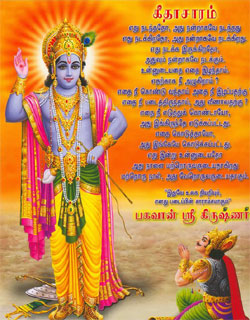
Hindu Festivals - Sri Krishna Jayanthi Vishnu, the preservative aspect of the universe and one of the Hindu Trinity, is said to take birth in this mortal world of ours whenever it is overburdened with evil-doers and sinners, who by their wicked actions upset the equilibrium of the earth. One such incarnation is his birth as the son of king Vasudeva and his wife Devaki Devi of bygone ages. He was then given the name of Sri Krishna, and his story is recorded in the famous work of the Hindus known as Bhagavatam. Born to rid the world of the wicked, he was secretly brought up by the chief of the Yadavas (cowherds) to whom he was taken as soon as he was born, since his uncle Kansa considered him an enemy and wanted to get rid of him as soon as he was born, by putting him to death. The birthday of this marvellous child is celebrated as a festive and sacred day on the eighth day of the dark fortnight in the month of Sravana called Avani in Tamil which corresponds to the English months of August-September. The festive day is known by different names. Some call it Krishna Jayanti day. A few call it Janma Ashtami day, while a good many call it Gokula Ashtami and Sri Jayanti. The myth relating to the advent of this mighty soul on earth is as sketched below: The mother earth is said to have brought to the notice of god Vishnu, that the population of the earth had enormously increased, that virtue was being trampled down by the tyrannical wicked and that she felt the burden rather unbearable. Vishnu thereupon is said to have consented to rid the earth of the superfluous population by destroying the wicked. To accomplish this purpose, he took birth on this earth, as the son of a king who was under the persecution of his brother-in-law, Kansa, a veritable demon in human shape. But he had to be secretly brought up by others to avoid being put to death by his cruel uncle. He is said to have accomplished the main object of his incarnation on this earth by having punished the wicked and helped the virtuous. The Dharma of each individual was fixed by him on a permanent basis, and proper arrangements were made for the protection and guidance of the world. This avatar or incarnation of Vishnu is said to be a typical one since he had combined in his divine personality the three aspects of creation, preservation and destruction to demonstrate to the world the oneness of the cosmic deity. That he was a typical and ideal child is demonstrated by his boyish freaks and escapades described in prose and verse and read and sung over the length and breadth of the land by thousands of people. His adventures with fhe gopis and the manner in which he made one and all love him, shows that he was a youth of marvelous beauty and an ideal lover. The destruction of the wicked and the masterly manner in which he conducted military operations shows that he was a warrior to the core, unparalleled in the annals of any history. A wise counsellor he assuredly was, and it is demonstrated by the decision arrived at by the Pandavas under his instructions. The teachings imparted by him to Arjuna on the battle field, graphically described in the famous work called Bhagavad Gita, reveal him as the greatest philosopher of all ages and times, and a yogi of the highest order. Though there are innumerable temples dedicated to Vishnu, the numbers dedicated to his incarnation as Sri Krishna are few and far between. The reason for this is perhaps that people have taken to worship him through paintings and not through temple images. The various forms in which Sri Krishna is worshipped are, (1) the Bala Gopala Krishna or the baby Krishna, (2) the crawling Krishna or Krishna as a child on all fours, (3) Govardhana Uddhara Krishna or Krishna who lifted up the mountain, (4) Venugopala Krishna or the cowherd Krishna with the flute, (5) Kalingamardana Krishna or Krishna in the posture of dancing on the head of a serpent to punish the same for its wickedness and (6) Radha Krishna and Rukmani Krishna or Krishna in company with Radha and Rukmani. In the great Mahabharata war, Sri Krishna acted as a charioteer to Arjuna, also called Partha. Hence he derived the name Parthasarathy or the charioteer of Partha. A temple is dedicated to him in this aspect at Triplicane in Madras, known as Sri Parthasarathy temple and it is one of the important temples in southern India. There is also a temple dedicated to Sri Krishna in Conjeevaram and it goes by the name Pandavadhoothar temple or the temple of Krishna who went as a messenger of the Pandavas. The temple in Mannargudi in the Tanjore district is known as Rajagopalaswami temple and it is dedicated to the memory of Vishnu's incarnation as Sri Krishna. There are also temples of this god in the holy place called Udipi in the South Canara district and at Trivanjikolam near Iringalakuda on the Shoranur-Cochin railway line. |
#36, Kalaimagal Nagar 2nd Main road, Ekkatuthangal, Chennai 600032, Tamilnadu, India. Phone No: 044 - 2433 1068. E-mail : customercare@jbsoftsystem.com
Powered by : J B Soft System, Chennai





